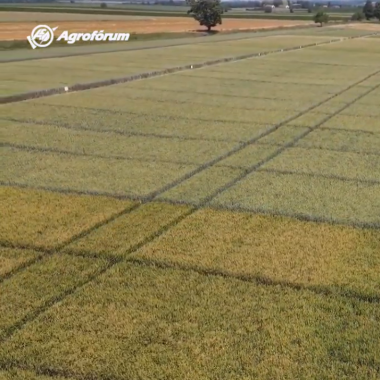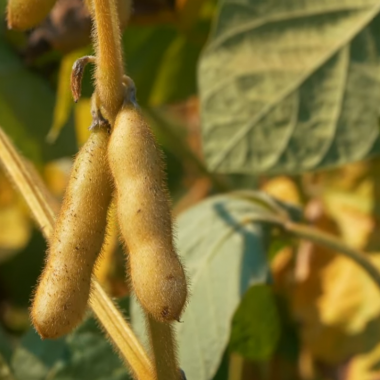Soybean is one of the most valuable high-protein legume crops. Due to their excellent nutritional qualities, soybeans may be used for the production of both human food and animal feed. Read our technology brochure to learn about the criteria for successful soybean production.
SOYBEAN PRODUCTION TECHNOLOGY
SELECTION OF SITE
- Optimum soil pH: 6.0-6.8. Suboptimum pH values may cause significant yield depression.
- Soybean will grow on most soils except loose sands and in saline areas.
- Secure and profitable production requires deep layered, medium heavy loam soils rich in nutrients and with an excellent water balance.
- Soybean makes good use of the water reserves in the soil, yet successful production usually presumes irrigation.
- The plant is sensitive to climatic conditions, temperature and precipitation.
- Soybean prefers a uniformly warm summer weather and needs rain and high humidity during flowering and in the Beginning Pod stage.
- An optimum field for soybean production is...
- ....free of perennial weeds
- ... free of perennial dicot weeds
- ... free of herbicide residues that might damage the plants
- Nitrogen fixed by soybean and left in the soil should be taken into account when planning crop rotation schemes.
the position of soybean in the crop rotation scheme
- Cereals are good pre-crops
- Maize is an acceptable pre-crop
- Soybean should not be grown after sunflower, rapeseed or sugar beet
- Soyabean is an excellent pre-crop, as it improves soil structure, reduces weed populations and leaves 25-70 kg/ha of nitrogen in the soil for the next crop.
- Early soybean varieties may be harvested early, leaving enough time for the tillage needed by winter cereals.
- It should not be followed by other legumes in the crop rotation as these will not sufficiently utilise the nitrogen left by soybean in the soil.
TILLAGE
- Cultivate the stubble after the early pre-crop (cereals) and close the soil surface.
- Keep the field free of weeds.
- The control of certain weeds (e.g. thistles and silkweed) should start a year before sowing the field with soybean.
- Finish off the field after the autumn deep ploughing.
- Prepare a properly finished, fine crumbled seedbed in the spring, while also making an effort to preserve soil moisture
- Provide for a level surface, otherwise harvest losses will increase significantly.
- Emergence is hindered on compacted, cracked soils.
INOCULATION OF SEEDS
- The bacterium Bradirhyzobium japonicum lives in the nodules developing on the roots of soybean and fixes atmospheric nitrogen.
- The plant is able to supply most of its own nitrogen needs from the nitrogen fixed in the nodules.
- To guarantee success, soybean seeds should be inoculated with bacteria before sowing.
- The use of inoculated seeds may improve the natural fixation of atmospheric nitrogen.
- Seeds may be inoculated either by the seed producer or the grower.
- Factory inoculated seeds are also treated with a fungicide in addition to the bacteria to guarantee excellent seed quality.
SOWING
- Row spacing: double or thrice as much as the normal row spacing for cereals or 45-50 cm for single seed drills.
- Sowing depth - 3-5 cm depending on how heavy the soil is and how much water it contains.
- Optimum seeding rate: 350-550 thousand plants/ha.
- For early varieties with less shoots: 500-600 thousand plants/ha.
- For medium early varieties with more shoots: 400-550 thousand plants/ha.
- By increased seeding rates, the plants usually grow taller. It may be an advantage, as even the lowest pods will develop high above the ground.
- By low seeding rates, the plant will probably develop more shoots. These will also produce pods; however, the lowest pods will be closer to the soil surface.
- Optimum sowing time: 15 April – 10 May, when the temperature of the soil does not drop below 12°C any more.
FERTILISATION
- Phosphorus and potassium fertilisers should be applied at tillage.
- Phosphorus uptake is most intense between the Beginning Seed and Maturation stages.
- The most potassium is taken up by plants in the Beginning Seed stage.
- Specific nutrient requirement of soybean per 1 tonne of yield: 50 kg/t N, 40 kg/t P2O5, 50 kg/t K2O, 10 kg/t MgO
- If possible, do not apply manure.
- About 40% of the nitrogen need of soybean is supplied by atmospheric nitrogen fixation.
- Nitrogen fertilisers should be applied in the autumn.
- Excessive nitrogen fertilisation should be avoided, as it may result in the propagation of weeds, late ripening or lodging, and may also stunt or prevent the development of root nodules.
- If no root nodules can be found in the soybean crop 1-1.5 months after emergence, nitrogen fertilisation will probably be necessary. Some of the necessary amount may be applied as a foliar treatment.
IRRIGATION
- Soybean production requires a lot of water (400-450 mm) for plant development as well as to maintain the necessary humidity in the stand.
- Soybean makes good use of the water reserved in the soil.
- Relatively drought tolerant before flowering and when maturing.
- It is important to provide sufficient water during flowering and in the full seed stage.
CROP PROTECTION
Weed control
- Soybean may be damaged by herbicide residues left behind by the pre-crop.
- Do not sow soybean after crops that have been treated with the active ingredients mesotrione, tembotrione, aminopyralid etc.
Most important weed species
- Perennial monocots: Johnson grass, quackgrass, Bermuda grass.
- Seed born monocots: Barnyardgrass, millets, proso millet.
- Perennial dicots: bindweed, thistle, silkweed, mugwort.
- Seed born dicots: common ragweed, lambsquarters, amaranths, jimsonweed, velvetleaf, rough cocklebur, bindweeds, knotweeds, weed sunflower.
Chemical weed control
- Pre-emergent treatment (within 3 days after sowing) - they need 10-14 mm rain within two weeks of the application to work efficiently
- against seed born monocots:
dimethenamid-P (Spectrum)
dimethenamid-P + pendimetalin (Wing-P)
pendimethalin (Stomp Super, Stomp Aqua, Sharpen 330 EC, Pendigan 330 EC)
S-metola chlorine (Dual Gold 960 EC)
clomazone (Command 48 EC)
- against seed born dicots:
metribuzin (Sencor, Sencor 600 SC, Mistral)
flumioaxin (Pledge 50 WP)
clomazone (Command 48 EC)
pendimetalin (Stomp Super, Stomp Aqua, Sharpen 330 EC, Pendigan 330 EC)
linuron (Afalon dispersion)
- Post-emergent (2-4 leaves stage)
- against monocots and dicots:
imazamox (Pulsar 40 SL) (do not apply directly after rain!)
- against dicots:
bentazon (Basagran 480 SL, Benta 480 SL, Troy 480)
tifensulfuron-metil (Refine 50 SX)
bentazon + imazamox (Corum)
- against monocots (later application also possible):
cycloxidim (Focus Ultra)
quizalofop-P (Pantera 40 EC, Leopard 5 EC, Targa Super)
cletodim (Select Super, Select 240 EC)
Mechanical weed control is also recommended in the interval before canopy closure
Most important pests and pathogens
Viruses:
- tobacco ringspot virus,
- Soybean mosaic virus
Control: soybean should be grown in the same field once in every 4 years, control of vectors using permitted products
Bacteria:
- bacterial blight,
- bacterial pustule,
- wildfire.
Control: soybean should be grown in the same field once in every 3 years, using certified, sealed and coated seeds, destroying diseased plant residues, balanced production technology, chemical control (using copper products) from the 2-3 leaves stage
Fungal pathogens:
- soybean downy mildew,
- Diaporthe pod and stem rot, Sclerotinia stem rot – typically in wet weather and by high humidity
- Fusarium wilt,
- charcoal rot.
Control: balanced fertilisation, observation of crop rotation rules, using certified, sealed and coated seeds, destroying diseased plant residues, chemical control. Chemical control is hindered by the lack of permitted products and the technlogical diffculties of spraying.
Insect pests:
- click beetles
- Melolonthinae (May beetles etc.)
- two spotted spider mite – may cause severe damage when the summer is dry and hot
- painted lady – present in the fields every year but rarely causes significant damage
- leaf weevils
- pulse pod borer
- aphids
- tobacco thrips
- Noctuid moths – may damage ripening beans
- southern green stink bug – appears at the end of the growing season
Control: observation of the rules of crop rotation, applying proper technology, sowing certified and coated seeds. The control of pests invading the stand late is complicated because no insecticides or miticides have been permitted for use in soybean. Emergency permits for insecticides to control the painted lady and weevils may be requested.
At least 3 soil pests/m2 (click beetle larvae, grubs) as measured by autumn or spring samplings shall justify soil disinfection as a pre-sowing treatment or during sowing.
Harvest and storage
- Right time for harvesting: the leaves have fallen, pods at the top matured, seeds have acquired the colour typical of the variety.
- Ideal moisture content: 14-16%. Over this value quality deteriorates. Below it, harvesting losses occur (shattering).
- When maturing is delayed, desiccation is needed.
- Using carefully selected settings on the harvester results in quantitative and qualitative gains.
- If the water content of the harvested crop exceeds 14-15%, cold air drying is recommended, where air temperature does not exceed 60 °C.
- Due to their high oil content, the beans should be stored at moisture content of 8-10%. At higher moisture levels, the beans may spoil and become rancid.
- Extra care is needed when storing soybeans, as damaged beans may become rancid and lose their value.


